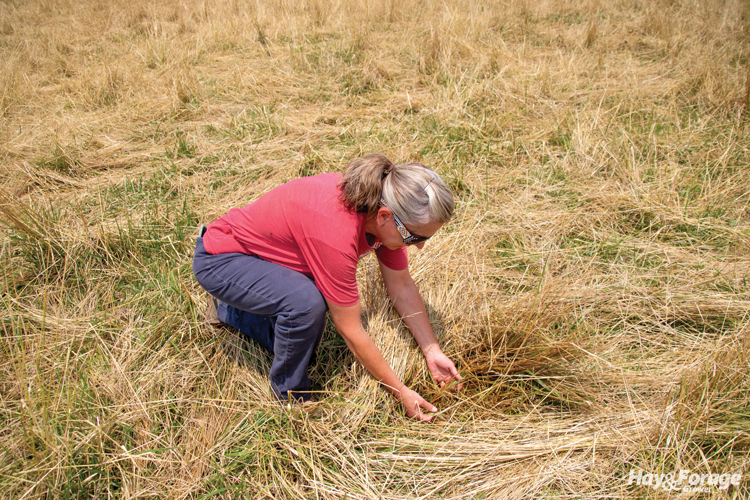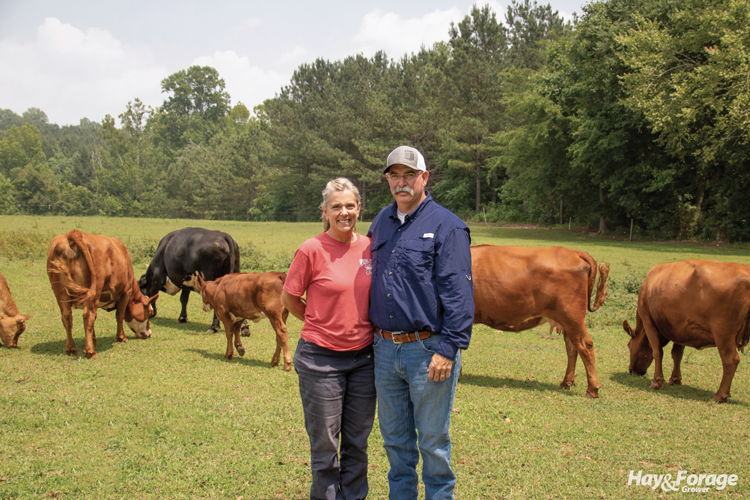
There is something charming about the colorful contrast of red cattle against the backdrop of green grass and a bright blue sky. At least that’s what Kim Woods thinks every time she sees her Red Angus and Hereford cows out on the pasture.
Kim and her husband, Chad, own and operate Spring Crest Farm located just south of Hurdle Mills, N.C. It is where she was born and grew up with dairy cattle after her family transitioned out of tobacco farming in the 1960s. A second transition came in the 1990s when Kim and Chad were married and their family decided to sell the cows and make small bales of orchardgrass hay for horses in the area.
“We are not far from Raleigh, Durham, and Chapel Hill where there is a fairly large population of equine and folks to purchase high-quality hay. We had the land, we had the equipment, and we had the storage, so it just made sense,” said Kim, who is an area extension agent with North Carolina State University.
The Woodses continued down this path of production for nearly 20 years before it became too difficult to find labor and maintain their haymaking business. Once again, the open-minded couple sought out a different farming opportunity and started raising pasture-based beef cattle for direct-to-consumer sales. They have since settled into a rhythm of production yet continue to tweak their grazing tactics to overcome challenges like harsh weather patterns and market swings. It goes without saying that the Woodses are not afraid to try new things.
A change of base
The couple currently has about 65 acres that were converted from orchardgrass to a novel-endophyte variety of tall fescue. They opted for this forage base to avoid the toxic effects of Kentucky-31 tall fescue. “We were a little skeptical that it wouldn’t make that much of a difference, but it has in terms of cattle performance and stand persistence,” said Chad, who works for the Carrboro Fire Department when he is not on the farm. “It has gone through some really high heat, some really cold winters, and some really dry spells, but it just keeps hanging on. I’ve been tickled with it.”
Instead of renovating all of the orchardgrass acres at once, the Woodses made a deal with a local row crop farmer to incorporate portions of the pasture into his corn and soybean rotation. It was a piecemeal process that took place over several growing seasons, but after the second harvest of each two-year rotation, the land was ready to be seeded to novel-endophyte tall fescue.
“It’s a unique situation with the row crop farmer,” Kim said. “It has worked out well to be able to plant our grass behind those couple of crops, and the farmer does a really good job. He uses Roundup Ready corn and soybeans, which helps with the weed pressure that can come up with the forage seedlings. We may have to adjust soil fertility a touch, but he does a good job with that, too.”
The Woodses still make hay on about 30 acres of novel-endophyte fescue that they feed to cattle in the fall. At the same time, they stockpile tall fescue fields to facilitate winter grazing. They set up polywire fences to divide stockpiled fields into 1- to 2-acre paddocks and then start strip grazing cattle at one end of a paddock by moving another line of polywire forward 30 to 40 feet per day.
“Strip grazing is the key to stockpiled fescue,” Chad declared. “And by that time of year, our calves have been weaned and the cows don’t have as great of a need for high-quality feed, so they can really make gains on the stuff.”
Spring stockpile trial
In 2023, the Woodses tried spring stockpiling for the first time. They removed their cattle from a 22-acre field of tall fescue in February to let the forage grow. New shoots started to emerge out of the trampled plants, but instead of rotationally grazing the fresh grass like they typically would, the couple implemented the same approach to stockpiling tall fescue that they do every fall.
“From March, April, and May, the tall fescue is beautiful and green. Then in September, October, and November, it’s beautiful and green again. It grows well those six months of the year, but the awesome thing is when we stockpile it, the nutrition stays,” Chad said.

By the middle of summer when the tall fescue was golden brown and headed out, the Woodses started to strip graze cattle on the stockpiled acres. This time, though, they created larger strips in the paddocks with polywire than they did in the winter — about 1/8 of an acre — to prolong the length of each grazing period and reduce the grazing pressure on the forage.
One morning in late June, Kim counted her steps out to the pasture on her way to move the herd forward to another strip of grass. Even though it took her longer to walk there than to complete the task at hand, it gave her time to consider the benefits of this type of intensive grazing management.
“It gives me the chance to assess the pasture and the cows as I’m walking out there. Do we still have good ground cover? Have we had many cases of pinkeye? And since we move the cows every other day, they are calmer and more easy-going,” Kim said. “Also, I need the exercise, so I’m not complaining,” she laughed.
Crazy for crabgrass
To boost their herd’s crude protein intake and overall forage quality, the Woodses leave the gate to a crabgrass field open for cattle while they occupy the spring stockpile. Animals have free access to the annual warm-season species and tend to retreat to this shaded part of the property when the sun hangs high in the afternoon sky. The couple noted the crabgrass is quite persistent, very palatable, and relatively easy to manage — especially because it does not require high input costs.
“When we were in the hay business, we hated it. Now it has become kind of a miracle forage for us,” Chad said. “We have tried other annuals, but they are not always a sure thing. For instance, last year and this year have both been too dry and we couldn’t risk spending money on the seed, time, and fuel. If it didn’t rain, it wasn’t coming up.”
Kim added, “What’s nice about crabgrass is that it doesn’t use a lot of fertilizer, and fertilizer prices the past few years have been crazy. Between fertilizer prices and the dry planting seasons we’ve been having, it’s not worth the risk to plant anything else. We have put some crabgrass seed out there, but we try to manage it so that it reseeds itself. It just comes back.”
The Woodses also supplement livestock diets with spent brewers grains they receive from breweries in Chapel Hill, one point of the Research Park Triangle, along with Raleigh and Durham, which are homes of North Carolina’s three major universities. In addition to breweries, Chad said the Triangle is riddled with small restaurants and eateries that emphasize local produce and pasture-based meats on their menus, including beef from Spring Crest Farm.
Farm-to-table focus
Having red-hided cattle was as much a nostalgic choice for Kim as it was a strategic one for the operation. “I grew up with Guernseys on our dairy, so I wanted to have red cows predominately on our farm,” she said. “We also took into consideration a red hide for grazing, knowing those cattle would tolerate the heat better than black-hided cattle,” Chad chimed in.
With that said, the Woodses also knew animals with red coats would receive a discount if sold at the local stock market. So, rather than sell their steer calves and cull cows to the stockyard, they decided to tap into direct sales. They soon discovered Firsthand Foods — a startup business that is committed to connecting small-scale farmers to customers in the community — and they have worked with the company ever since.
Firsthand Foods buys the Woodses’ live cattle, has them processed, and then distributes the beef to local retailers. The company also provides retailers with information about individual animals and the farmers who raised them. “It’s all about traceability,” Chad said. “If they sell a rib eye at a restaurant and somebody says, ‘This is the best rib eye I’ve ever had,’ they can trace the meat back to the specific cow.”
If that specific cow belonged to the Woodses, they will be notified about the food review. “We get that feedback and can tweak our operation to improve the eating experience for those customers,” Kim explained. “We can potentially improve our genetics or our forages or fine-tune the feeding program that we are following.”
One thing that makes the Woodses stand out among other farmers who partner with Firsthand Foods is that their cows calve in the spring. Since most other operations in the area have fall-calving herds, the couple can market their beef at the opposite time of year and fill gaps in the company’s supply chain. This points back to their pasture base. With novel-endophyte tall fescue, the Woodses can graze cattle throughout the summer breeding season without fescue toxicosis threatening conception rates.
Along with Firsthand Foods, the Woodses occasionally sell beef to friends and family. They have also sold steer calves to other farmers who finish the beef, and they have sold heifers to neighbors who want to grow their own herd. “We do a little bit of everything. It just depends on what the market is doing and the opportunities that arise,” Kim said with a shrug.
This outlook might explain the history of the Woodses’ ever-changing operation; however, the couple will stay in the beef business for the foreseeable future. They want to continue to convert their remaining pasture acres to novel-endophyte tall fescue and eventually phase out of haymaking. They will adjust their stockpiling schedules and strip grazing strategies, and they will keep grazing crabgrass in the summer. And overall, the Woodses plan on maintaining their herd size of about 20 cows — 20 red cows, that is. •
This article appeared in the April/May 2024 issue of Hay & Forage Grower on pages 20-22.
Not a subscriber? Click to get the print magazine.

